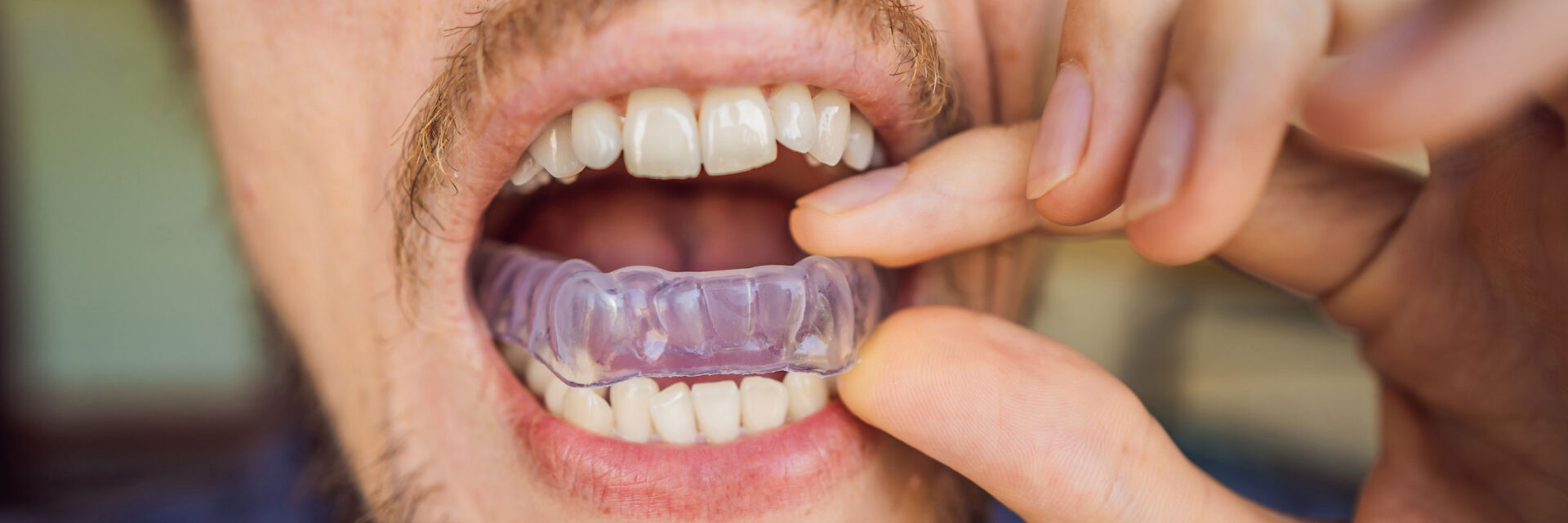Bruxism, or teeth grinding, can lead to various symptoms and complications, making it necessary for many to explore alternative treatment options, at least while they seek professional medical treatment.
And even then, many dental health care providers will recommend several lifestyle changes and habits to complement effective, long-term treatment of bruxism.
Two such options for bruxism relief are meditation and mindfulness. We’ll explore in this blog post the potential benefits of meditation and mindfulness practices in alleviating bruxism, a condition characterized by teeth grinding and clenching.
Often resulting in tooth damage, head, neck, facial pain and even the ears. Repeated grinding puts excessive pressure on the temporomandibular joint (TMJ), leading to jaw pain and limited movement. In some cases, this can also lead to headaches, tooth sensitivity, and worn-down teeth.
Drawing upon the principles of mindfulness and meditation, we’ll investigate how these practices can help individuals manage bruxism symptoms and improve overall well-being. By examining the existing literature and research, this article provides valuable insights into the potential efficacy of meditation and mindfulness as complementary approaches to bruxism relief.
the face, neck, and even the ears. Repeated grinding puts excessive pressure on the temporomandibular joint (TMJ), leading to jaw pain and limited movement. In some cases, this can also lead to headaches, tooth sensitivity, and worn-down teeth.
 The risk factors for bruxism are varied but also not conclusive or beyond any scientific doubt. However, a few have proven true in enough studies to be certain they play at least an important part, specifically stress and anxiety, temporomandibular joint disorder (TMJ), and sleep apnea.
The risk factors for bruxism are varied but also not conclusive or beyond any scientific doubt. However, a few have proven true in enough studies to be certain they play at least an important part, specifically stress and anxiety, temporomandibular joint disorder (TMJ), and sleep apnea.
 One of the most promising long-term treatment options for bruxism is mindfulness meditation.
First, let’s we’ll do an overview of meditation and its various forms will be provided, highlighting its potential benefits for managing stress and promoting relaxation.
Then, specific types of meditation that have shown promise in reducing teeth grinding will be explored, including concentration meditation and loving-kindness meditation.
One of the most promising long-term treatment options for bruxism is mindfulness meditation.
First, let’s we’ll do an overview of meditation and its various forms will be provided, highlighting its potential benefits for managing stress and promoting relaxation.
Then, specific types of meditation that have shown promise in reducing teeth grinding will be explored, including concentration meditation and loving-kindness meditation.
 While meditation and mindfulness can be crucial in treating and preventing bruxism, we can’t forget about the immediate dental treatments that are also key to relieving and stopping damage from the effects of teeth grinding and clenching during sleep.
These options include night guards, physical therapy, and other relaxation techniques apart from meditation.
While meditation and mindfulness can be crucial in treating and preventing bruxism, we can’t forget about the immediate dental treatments that are also key to relieving and stopping damage from the effects of teeth grinding and clenching during sleep.
These options include night guards, physical therapy, and other relaxation techniques apart from meditation.
Damage to Teeth and Gums
Damage to teeth and gums can occur as a result of the excessive force exerted during teeth grinding or clenching. The force exerted during teeth grinding can cause tooth enamel to wear down, leading to increased tooth sensitivity. The constant grinding motion puts strain on the jaw muscles, causing jaw pain, headache and discomfort. Over time, this can also result in damage to the teeth and gums, including fractures, chips, and gum recession. Therefore, it is crucial to seek appropriate interventions to prevent further damage to the oral health.Tension in Facial Muscles and Neck Muscles
Tension in facial muscles and neck muscles can result from the repetitive grinding or clenching of teeth. This condition is often associated with high levels of stress and anxiety.Sleep Disorders
Sleep disorders are a common issue that often coexists with bruxism, making it crucial to address both conditions for effective relief. The constant nighttime teeth grinding and clenching at night can disrupt sleep patterns and exacerbate existing sleep disorders. Individuals with bruxism may experience insomnia, sleep apnea, or restless leg syndrome, further impacting their well-being. This is one of the symptoms that can be targeted the best by mindfulness and meditation techniques, which have shown promise in alleviating sleep disorders and reducing bruxism symptoms. By cultivating a state of relaxation and awareness, these practices can help individuals manage stress and anxiety and promote better sleep quality. You can also protect your teeth at night using night guards that can provide a physical barrier to protect the teeth and alleviate bruxism-related symptoms.Risk Factors for Bruxism
 The risk factors for bruxism are varied but also not conclusive or beyond any scientific doubt. However, a few have proven true in enough studies to be certain they play at least an important part, specifically stress and anxiety, temporomandibular joint disorder (TMJ), and sleep apnea.
The risk factors for bruxism are varied but also not conclusive or beyond any scientific doubt. However, a few have proven true in enough studies to be certain they play at least an important part, specifically stress and anxiety, temporomandibular joint disorder (TMJ), and sleep apnea.
Stress and Anxiety
Stress and anxiety have been identified as significant contributors to the development and exacerbation of daytime bruxism, a condition characterized by the involuntary grinding and clenching of teeth. The physiological response to stress and anxiety, such as increased muscle tension and activation of the sympathetic nervous system, can lead to the manifestation of bruxism. Individuals may consider incorporating meditation and mindfulness techniques into their daily routine to alleviate bruxism symptoms. These practices aim to reduce stress and anxiety by promoting relaxation, mental focus, and emotional well-being.TMJ Disorders
The temporomandibular joint (TMJ) is a hinge joint that connects the jawbone to the skull. You have two TMJ joints, one on either side of your head. They allow the jaw to move freely for chewing and talking. They also allow for the opening and closing of the mouth and the side-to-side movement of the lower jaw. TMJ disorders refer to a group of conditions that affect the normal functioning of this joint. Common symptoms include jaw pain, clicking or popping sounds, difficulty chewing, and headaches. These disorders can significantly impact one’s quality of life and overall health. Treatment options for TMJ disorders vary depending on the severity of the condition and may include conservative measures such as pain medications, physical therapy, and the use of a mouth guard to protect the teeth from excessive wear due to grinding. In more severe cases, surgical intervention may be necessary. Consulting with a Dentist for proper diagnosis and appropriate treatment is important.Sleep Apnea
Sleep apnea is a sleep disorder characterized by pauses in breathing or shallow breaths during sleep. It can lead to fragmented sleep and daytime sleepiness, affecting the overall quality of life. Bruxism, or teeth grinding, is a common symptom associated with sleep apnea. While the primary treatment for sleep apnea is continuous positive airway pressure (CPAP) therapy, mindfulness and meditation techniques have shown potential in providing relief from bruxism symptoms.Mindfulness Meditation for Teeth Grinding
 One of the most promising long-term treatment options for bruxism is mindfulness meditation.
First, let’s we’ll do an overview of meditation and its various forms will be provided, highlighting its potential benefits for managing stress and promoting relaxation.
Then, specific types of meditation that have shown promise in reducing teeth grinding will be explored, including concentration meditation and loving-kindness meditation.
One of the most promising long-term treatment options for bruxism is mindfulness meditation.
First, let’s we’ll do an overview of meditation and its various forms will be provided, highlighting its potential benefits for managing stress and promoting relaxation.
Then, specific types of meditation that have shown promise in reducing teeth grinding will be explored, including concentration meditation and loving-kindness meditation.
What is Meditation
Meditation is a practice that involves focusing one’s attention and eliminating the constant stream of thoughts in order to achieve a calm and relaxed state of mind. It is a technique that has been used for centuries in various cultures and religions and has gained popularity in recent years due to its numerous benefits. When practicing meditation, individuals are encouraged to find a quiet and comfortable space where they can sit or lie down. They are then instructed to focus their attention on a specific object, such as their breath or a mantra (repeated words, phrases, or sounds) in order to quiet the mind and bring about a sense of inner peace. This practice can have a variety of positive effects on both physical and mental health, including reduced stress levels, improved concentration, and increased feelings of well-being. Meditation has also been found to promote better sleep, enhance self-awareness and emotional regulation, and even support the development of positive qualities such as compassion and gratitude.Types of Meditation for Teeth Grinding
One approach to managing teeth grinding, known as progressive muscle relaxation, involves systematically tensing and then relaxing different muscle groups in the body to promote a sense of overall relaxation and reduce tension in the jaw. This technique aims to increase self-awareness and reduce stress levels, which could contribute to bruxism. By engaging in this practice, individuals can learn to identify and release tension in their muscles, including those in the jaw. Progressive muscle relaxation is often used as a part of a comprehensive treatment plan for bruxism, alongside other strategies such as stress management and behavioral therapy. It may be particularly beneficial for individuals who experience teeth grinding as a result of stress or anxiety. Incorporating progressive muscle relaxation into a daily routine could potentially help individuals manage their bruxism symptoms and improve their overall well-being.Breathing Exercises
Continuing the exploration of meditation and mindfulness for bruxism relief, the focus now turns to breathing exercises as a potential remedy. Breathing exercises are fundamental to various meditation practices and can offer considerable benefits in managing teeth grinding. These exercises involve deliberate control and awareness of one’s breath patterns, promoting relaxation and reducing stress levels. By engaging in slow, deep breaths, individuals can activate the body’s relaxation response, decreasing muscle tension and potentially alleviating bruxism symptoms. Conscious breathing can enhance mindfulness by redirecting attention to the present moment, allowing individuals to observe their thoughts and emotions without judgment. Incorporating breathing exercises into a meditation routine may provide a holistic approach to addressing bruxism, promoting overall well-being, and serving those seeking relief from teeth grinding.How Do Breathing Exercises and Meditation Help?
Through relaxation techniques, such as controlled breathing and mindfulness meditation, individuals can experience a sense of calmness and tranquility that promotes better sleep. These practices have also been found to reduce stress levels, leading to improved overall well-being. So, by cultivating a heightened sense of self-awareness through meditation and breathing exercises, individuals can become more attuned to their own physical and mental states, allowing for early detection of symptoms and timely intervention.Improved Sleep Quality through Relaxation Techniques
Accepting into your daily routine relaxation techniques such as meditation and mindfulness has been found to enhance the quality of sleep among individuals with bruxism. Bruxism, the involuntary grinding or clenching of teeth during sleep, can lead to disrupted sleep patterns and subsequent daytime fatigue, on top of all other dental issues like crooked teeth, tooth wear, broken teeth, and even loss of teeth. Research suggests that practicing relaxation techniques before bedtime can help reduce the symptoms of bruxism and promote better sleep. Meditation and mindfulness techniques can induce a state of deep relaxation, reducing muscle tension and promoting a sense of calmness. By quieting the mind and focusing on the present moment, individuals with bruxism can alleviate stress and anxiety, often contributing to teeth grinding. As a result, these relaxation techniques can improve sleep quality and overall well-being, allowing individuals to wake up feeling refreshed and rejuvenated.Reduction in Stress Level
Stress reduction is crucial in promoting better sleep quality and overall well-being among individuals with bruxism. People who are nighttime teeth grinders are more than twice as likely to report severe stress, according to a study from the Institute of Dentistry, University of Helsinki, Finland: “Adjusted by age and gender, frequent bruxers were more than two times more likely to report severe stress (odds ratio 2.5; 95% confidence interval 1.5-4.2) and anxiety (odds ratio 2.2; 95% confidence interval 1.3-3.6) than non-or-mild bruxers. Conclusions: Present findings suggest that self-reported bruxism and psychological states such as anxiety or stress may be related in working-age subjects.” Therefore, implementing effective stress reduction strategies is essential for managing bruxism and improving the quality of sleep in affected individuals. Meditation and mindfulness techniques have been shown to effectively reduce stress levels and promote relaxation.Increased Self-Awareness for Early Detection of Symptoms
Increased self-awareness can play a vital role in detecting symptoms of bruxism early and identifying potential triggers that may contribute to teeth grinding during sleep. By cultivating a heightened sense of self-awareness, individuals can become more attuned to bruxism’s physical and psychological manifestations. This awareness allows for the identification of common symptoms such as jaw pain, headaches, and worn-down teeth, enabling early intervention and treatment. Mindfulness practices, such as meditation and relaxation techniques, can enhance self-awareness, enabling individuals to monitor their oral health and make informed decisions regarding their well-being. Developing self-awareness is therefore crucial for individuals who desire to serve others by promoting early detection and effective management of bruxism symptoms.Treatment Options for Bruxism
 While meditation and mindfulness can be crucial in treating and preventing bruxism, we can’t forget about the immediate dental treatments that are also key to relieving and stopping damage from the effects of teeth grinding and clenching during sleep.
These options include night guards, physical therapy, and other relaxation techniques apart from meditation.
While meditation and mindfulness can be crucial in treating and preventing bruxism, we can’t forget about the immediate dental treatments that are also key to relieving and stopping damage from the effects of teeth grinding and clenching during sleep.
These options include night guards, physical therapy, and other relaxation techniques apart from meditation.

